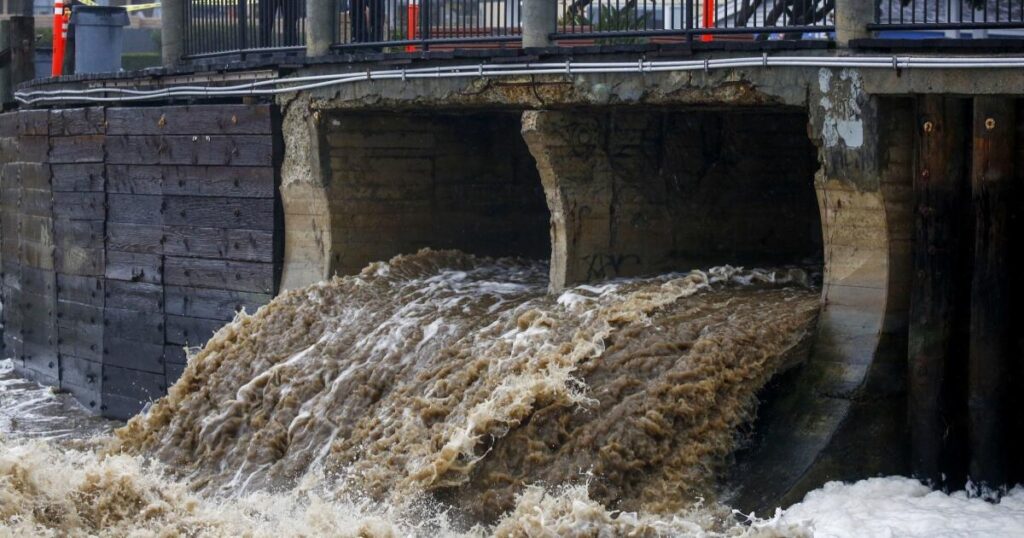Reporting from Sacramento — Storm water has been rampaging down the Sacramento River, carrying ripped out docks, uprooted trees and homeowners’ backyards, hellbent for the Golden Gate. But very little of this precious water can be saved.
Environmental restrictions limit the amount of water that can be pumped into southbound aqueducts. That’s because the pumps are deadly for fish, particularly young salmon trying to reach the ocean.
Moreover, there aren’t many places to store the water and reservoirs are filling up fast.
The principal answer to the pumping problem is highly controversial. It’s the long-debated tunnel proposal for the Sacramento-San Joaquin River Delta. A monster tunnel would siphon Sacramento River water at the top end of the delta and move it 35 miles under the estuary directly to the aqueducts, avoiding the pumps.
One solution to the storage shortage is below the ground. There should be more basins to spread out water — perhaps fallowed cropland. The water then could soak into the aquifer and be banked until it’s needed in a drought.
San Joaquin Valley farmers have been dangerously over-pumping groundwater. That has dried up wells and caused some land to perilously sink. By law, their groundwater use must be sustainable by 2040. That means taking at least 500,000 acres of farmland out of production, according to a new report by the Public Policy Institute of California.
This is wonky stuff, but it’s the lifeblood of California’s economy. Homes don’t get built unless there’s guaranteed water for the families. That’s the law. And agriculture lives off it. Growers use 80% of California’s developed water.
“We’re not running out of water in California. We’re running out of cheap water,” says Jeffrey Mount, a water expert at the policy institute and a former UC Davis earth sciences professor. “Any way you look at it, it’s going to get more expensive.”
If you stand on a fragile levee of the Sacramento River these days and watch the chocolate brown water rushing toward the delta only a few feet under your boots, one can’t help but wonder why the state and federal governments aren’t capturing more of this precious resource. Why is all but a tiny fraction heading out to sea?
On Presidents Day, at the peak of a vicious Sierra storm, 161,000 cubic feet of water per second (cfs) was rolling through the delta toward the Pacific, according to state officials. That’s equivalent in size to 161,000 basketballs rumbling by each second. A daylong flow of just one cubic foot of water per second will produce two acre-feet of water, enough to supply four households a year.
At the height of a deadly flood 22 years ago, 500,000 cfs was rushing through the delta.
How much was being pumped south in the recent storm? About 12,000 cfs by state and federal pumps combined. That’s the legal limit because pumping causes the San Joaquin River to flow in reverse, confusing immature salmon. Many wind up being sucked into the pumps, others devoured by wily predators.
Sometimes the pumps aren’t allowed to operate at all.
“Right now when we’ve got a lot of water in the system, we don’t have the ability to capture it and store for later,” says Erin Mellon, spokeswoman for the state Department of Water Resources.
That was one reason for former Gov. Jerry Brown’s embattled twin-tunnels project. Gov. Gavin Newsom has scaled it back to one tunnel in an effort to find a grand compromise.
With one tunnel, 6,000 cfs could be captured on top of the 12,000 cfs at the pumps. Or, to spare fish, pumping could be reduced by 6,000 cfs.
The twin-tunnel proposal was priced at $17 billion. A single tunnel is around $11 billion. Southern Californians would be the main bankrollers by paying higher rates on their water bills.
If you’re a delta farmer, local resident or Northern California environmentalist, there’s a lot to fear about even one tunnel.
It would be at least 40 feet wide and construction would chew up bucolic pear orchards, a waterfowl preserve and isolated backwaters enjoyed by boaters and anglers. Quaint marinas, bars and restaurants would be harassed. Trucks hauling excavated muck and machinery would clog narrow levee roads for a decade.
After completion, the tunnel would rob the interior delta of significant fresh water from the Sacramento River, creating more salinity — not fit for crops and hard on little communities.
That’s not a problem during a wet winter, but it could be in summer, particularly a dry year. Last September, delta flows dropped to nearly 5,000 cfs.
And northerners worry that in the future San Joaquin Valley growers and Southern Californians will become even thirstier for delta water.
For the 25 million non-delta Californians who rely on the estuary for much of their water, however, a tunnel would ensure a more reliable supply. The dicey killer pumps would be used less.
Water managers fear that the delta could succumb to rising sea levels or levee breaks. Earthquakes also are a bogeyman, although delta levees have never been seriously damaged by any temblor.
One advantage for delta people of a single tunnel — rather than twins — is that “it reduces the capacity for environmental harm, reduces the capacity for mismanagement,” Mount says. “And there wouldn’t be as much muck to deal with.”
We’ll always have rampaging rivers and flood threats. The question is whether competing interests can unite behind a way to capture more of nature’s pricey gift.
Coverage of California politics »
Twitter: @LATimesSkelton







